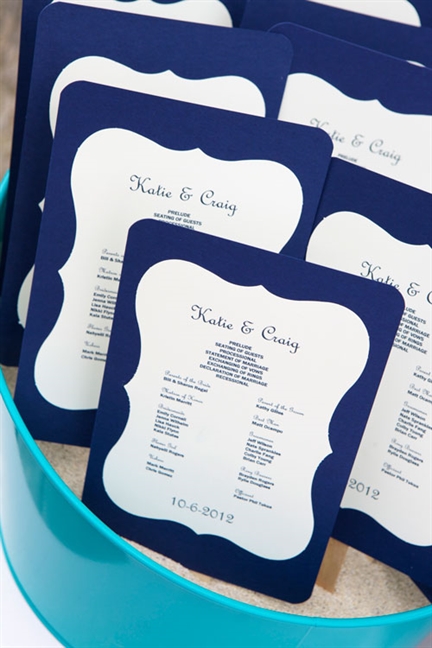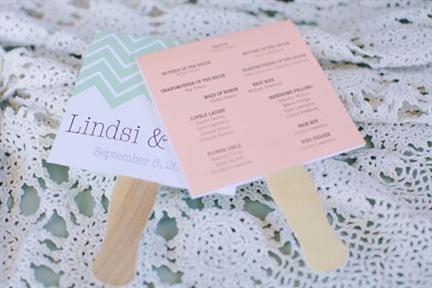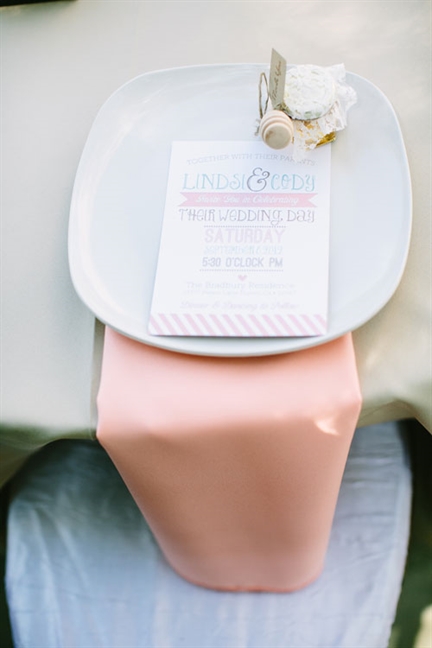By: Cynthia Zatkin Blase

Before such an appointment, how should a bride prepare? Denise Scatena, owner of Blue Ribbon Invitations, says that “we ask [our clients] to think about and be prepared to discuss their theme, the information they need to include, the quantity and their budget.” Victoria Schaefer-Ramirez of Theory Weddings and Events adds that a bride should also be prepared to discuss the time of day, when the wedding will occur, whether it is outdoors or indoors and the degree of formality. All of these factors need to be considered in designing the perfect invitation. So let’s get back to theme. How does a bride figure out, what Scatena calls, her “style and sentiment?”

First, find a starting point. A fantastic piece of decorative paper, a photo from an art or photographic book, a style of décor, an era from fashion, a particular color or article of clothing off the runway—all can be tipping points that engender the décor of a wedding. Many brides will assemble pieces of inspiration from magazines and the internet and cart those around with her to her various vendor appointments. Scatena says that “If a bride has a project/idea notebook with color swatches and photos it is very helpful!” But “whether they come to us with a clear idea of what they would like or with just a few starting points (the palette of the wedding, the venue, the flowers, for instance),” says Montoya, “we will collaborate throughout the design and print process to create an invitation that they will fall in love with.” Once a design is picked, then what happens next? Enclosures!
Invitations need to be specialized according to the complexities of each particular wedding. “At the very least,” says Scatena “a bride should have the main invite card, a respond set and a return address printed on the back flap of the outer envelope. If the ceremony and the reception are at two different locations, I highly recommend including a second enclosure card, with the reception location and address.” Enclosure cards can also “share information about your wedding website, and encourage your guests to visit and learn more about hotels in the area, things to do and more details about your celebration, like the rehearsal dinner or the day after brunch.”
Montoya also suggests that “if most of the guests will be traveling from out of town, I might suggest including directions and accommodations enclosures.” Also, she continues that “some cultures require that an enclosure with the bridal entourage listed be included in the suite.” There’s definitely a lot to consider! An invitation specialist will assist each couple with figuring out exactly what would work best in their particular invitation. After the design and enclosures are picked, the last two pieces are wording and styles of addressing. An invitation consultant will help a bridal couple “with their wording and are [further] available to answer any etiquette questions,” say Scatena. Will the parents initiate the invitation or will it come from the bride and groom? Will a style of dress be suggested? Will the language be formal or more casual? These are all great factors to discuss!

Then will names and addresses be printed on the invitations in the same style of font as is in the invitation or will a calligrapher be hired to address them by hand? “Increasingly, my clients are choosing to have their guest names and addresses typeset on either the front of their outer envelopes or on envelope icings, which are long labels that wrap around the outer envelope and add color and design to the invitation,” says Scatena. “The addresses are in the fonts that match the invitation ensemble and add a nice touch, especially for those brides not comfortable hand addressing [the invitations] themselves.” Scatena further adds that “this feature is also typically cheaper than handwritten calligraphy.” But for those wanting a more traditional look, calligraphy is still a wonderful option! There are great calligraphers who will pick up and drop off your invitations and can inscribe names on fun wedding extras like unique placecards or favors.
Then finally, there’s timing. How far in advance should a bride begin the process of creating her invitation? When speaking of an ideal timeline, Scatena says “we need four to six weeks to design and order an invitation ensemble. Then a bride and groom should have at least two weeks to assemble and address the invitation. The invitations should be sent six to eight weeks before your RSVP date (eight weeks for a destination wedding or if a majority of your guests will be traveling in for your celebration).” RSVP dates are important to consider! “Your RSVP date depends on when you have to give your count to the caterer,” continues Scatena. “I recommend to all clients to give an RSVP date about two weeks before your count is due to the caterer.” Scatena sums all that up by recommending a bride order the “invitations at least five months before the wedding date and begin shopping and designing the invitations about six months before your wedding date.” Montoya says that an invitation consultant can do all that in three months, if necessary. But rush jobs can add extra fees so starting early is good for the budget!
And what is the goal of all this? What is the goal of all the brainstorming of style, discussing enclosures, wording, and labeling? Said perfectly by Ramirez, to “‘hit it’—to create the perfect design!” The perfect, unique, one-in-a-million, my-wedding is-going-to-be-awesome design!